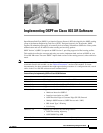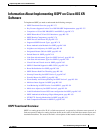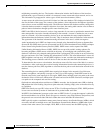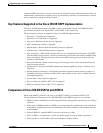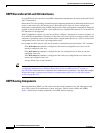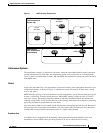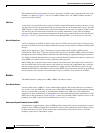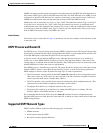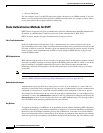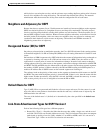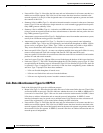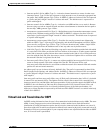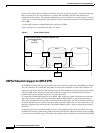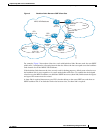
Implementing OSPF on Cisco IOS XR Software
Information About Implementing OSPF on Cisco IOS XR Software
RC-178
Cisco IOS XR Routing Configuration Guide
OL-14356-01
The backbone itself has all properties of an area. It consists of ABRs, routers, and networks only on the
backbone. As shown in Figure 1, Area 0 is an OSPF backbone area. Any OSPF backbone area has a
reserved area ID of 0.0.0.0.
Stub Area
A stub area is an area that does not accept or detailed network information external to the area. A stub
area typically has only one router that interfaces the area to the rest of the autonomous system. The stub
ABR advertises a single default route to external destinations into the stub area. Routers within a stub
area use this route for destinations outside the area and the autonomous system. This relationship
conserves LSA database space that would otherwise be used to store external LSAs flooded into the area.
In Figure 1, Area 2 is a stub area that is reached only through ABR 2. Area 0 cannot be a stub area.
Not-so-Stubby Area
A Not-so-Stubby Area (NSSA) is similar to the stub area. NSSA does not flood Type 5 external LSAs
from the core into the area, but can import autonomous system external routes in a limited fashion within
the area.
NSSA allows importing of Type 7 autonomous system external routes within an NSSA area by
redistribution. These Type 7 LSAs are translated into Type 5 LSAs by NSSA ABRs, which are flooded
throughout the whole routing domain. Summarization and filtering are supported during the translation.
Use NSSA to simplify administration if you are a network administrator that must connect a central site
using OSPF to a remote site that is using a different routing protocol.
Before NSSA, the connection between the corporate site border router and remote router could not be
run as an OSPF stub area because routes for the remote site could not be redistributed into a stub area,
and two routing protocols needed to be maintained. A simple protocol like RIP was usually run and
handled the redistribution. With NSSA, you can extend OSPF to cover the remote connection by defining
the area between the corporate router and remote router as an NSSA. Area 0 cannot be an NSSA.
Routers
The OSPF network is composed of ABRs, ASBRs, and interior routers.
Area Border Routers
An area border routers (ABR) is a router with multiple interfaces that connect directly to networks in
two or more areas. An ABR runs a separate copy of the OSPF algorithm and maintains separate routing
data for each area that is attached to, including the backbone area. ABRs also send configuration
summaries for their attached areas to the backbone area, which then distributes this information to other
OSPF areas in the autonomous system. In Figure 1, there are two ABRs. ABR 1 interfaces Area 1 to the
backbone area. ABR 2 interfaces the backbone Area 0 to Area 2, a stub area.
Autonomous System Boundary Routers (ASBR)
An autonomous system boundary router (ASBR) provides connectivity from one autonomous system to
another system. ASBRs exchange their autonomous system routing information with boundary routers
in other autonomous systems. Every router inside an autonomous system knows how to reach the
boundary routers for its autonomous system.




